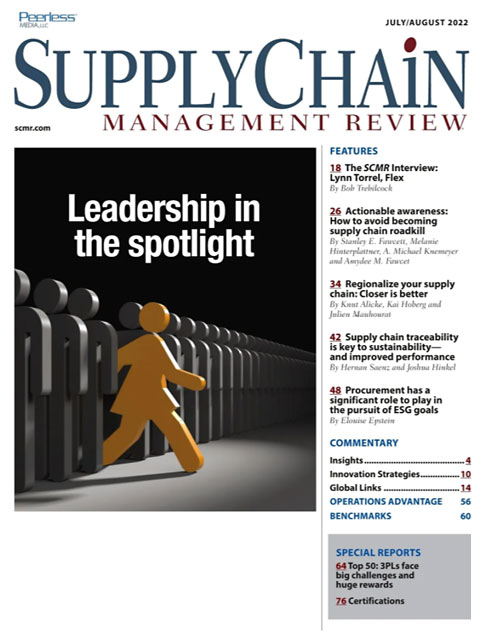Sorry, but your login has failed. Please recheck your login information and resubmit. If your subscription has expired, renew here.
July-August 2022
In late May, I attended the Institute for Supply Management’s first live conference since 2019. The message from Tom Derry, ISM’s CEO, was simple: These are challenging times, but along with the challenges come opportunities for those of us who can step up and lead our organizations into the future. One area where supply chain will be tasked with stepping up to the plate is going to be ESG, the initialism for environmental, social and governance. It was a major theme of the conference, and while all of the reporting requirements are still being debated, there’s little question that supply chain will lead the charge in environmental initiatives… Browse this issue archive.Need Help? Contact customer service 847-559-7581 More options
In today’s customer-focused culture, supply chain networks are under continuous pressure to remain competitive, deliver quality service and to find innovative ways to optimize their operations. Drawing on our experience, we will focus on the road ahead as companies traverse the historical challenges facing the transportation industry and search for a holistic approach to manage the rocks in the road.
Expanding on the people, process and technology framework, we will explore what components are aligned to the strategic operating model necessary to drive market adaptability to guide organizations in the years ahead.
Keep your eyes on the road ahead
The transportation industry is experiencing unprecedented levels of change accelerating in 2020. Global supply chain disruptions, both intended and unintended, initiated by the pandemic amid economic/geopolitical
events, have continued to impede businesses in their quest to perform the basic functions of procuring and delivering goods in a timely fashion. These challenges, along with the increasing demand for more frequent, time-sensitive home deliveries, have created more stress on supply network ecosystems and transportation providers than ever before.
Companies must face the harsh reality that in addition to increasing transportation capabilities and capacity to meet today’s substantial challenges, they must now prepare for an era of extraordinary technological advances that will affect daily life in new and innovative ways. These advances will require innovative, structurally-driven processes to meet further increasing customer expectations.
The structural challenges and future trends detailed in Figure 1 highlight the need for companies to remain nimble in the face of rapidly changing expectations that affect transportation operations. Business capabilities and supporting technologies, as well as operational processes, must constantly evolve to remain current with on-going requirements while keeping an eye on the road, anticipating changes from future trends and innovations affecting the transportation industry. Resilience results from response. Response results from foresight.
If companies fail to constantly adapt and evolve their transportation capabilities to adequately meet daily business expectations or adapt to critical industry trends, they will find themselves battling rising costs to deliver products to dwindling consumer bases.

This complete article is available to subscribers only.
Log in now for full access or start your PLUS+ subscription for instant access.
SC
MR
Sorry, but your login has failed. Please recheck your login information and resubmit. If your subscription has expired, renew here.
July-August 2022
In late May, I attended the Institute for Supply Management’s first live conference since 2019. The message from Tom Derry, ISM’s CEO, was simple: These are challenging times, but along with the challenges come… Browse this issue archive. Access your online digital edition. Download a PDF file of the July-August 2022 issue.In today’s customer-focused culture, supply chain networks are under continuous pressure to remain competitive, deliver quality service and to find innovative ways to optimize their operations. Drawing on our experience, we will focus on the road ahead as companies traverse the historical challenges facing the transportation industry and search for a holistic approach to manage the rocks in the road.
Expanding on the people, process and technology framework, we will explore what components are aligned to the strategic operating model necessary to drive market adaptability to guide organizations in the years ahead.
Keep your eyes on the road ahead
The transportation industry is experiencing unprecedented levels of change accelerating in 2020. Global supply chain disruptions, both intended and unintended, initiated by the pandemic amid economic/geopolitical
events, have continued to impede businesses in their quest to perform the basic functions of procuring and delivering goods in a timely fashion. These challenges, along with the increasing demand for more frequent, time-sensitive home deliveries, have created more stress on supply network ecosystems and transportation providers than ever before.
Companies must face the harsh reality that in addition to increasing transportation capabilities and capacity to meet today’s substantial challenges, they must now prepare for an era of extraordinary technological advances that will affect daily life in new and innovative ways. These advances will require innovative, structurally-driven processes to meet further increasing customer expectations.
The structural challenges and future trends detailed in Figure 1 highlight the need for companies to remain nimble in the face of rapidly changing expectations that affect transportation operations. Business capabilities and supporting technologies, as well as operational processes, must constantly evolve to remain current with on-going requirements while keeping an eye on the road, anticipating changes from future trends and innovations affecting the transportation industry. Resilience results from response. Response results from foresight.
If companies fail to constantly adapt and evolve their transportation capabilities to adequately meet daily business expectations or adapt to critical industry trends, they will find themselves battling rising costs to deliver products to dwindling consumer bases.
SC
MR


More 3PL
- 2024 Warehouse/DC Operations Survey: Technology adoption on the rise
- Looking back at NextGen 2024
- Manufacturing again contracts in October, reports ISM
- Parcel shipping spend: The untamed holdout in today’s supply chains
- NextGen Supply Chain Conference set for October 21-23
- Penske, NTT Data, CSCMP study finds change still dominates 3PL market
- More 3PL
Latest Podcast

 Explore
Explore
Business Management News
- 2024 Warehouse/DC Operations Survey: Technology adoption on the rise
- Benchmarking the complexity of ESG reporting
- Looking back at NextGen 2024
- The Corporate Sustainability Due Diligence Directive
- How to make your CFO a supply chain superfan
- Manufacturing again contracts in October, reports ISM
- More Business Management
Latest Business Management Resources

Subscribe

Supply Chain Management Review delivers the best industry content.

Editors’ Picks





